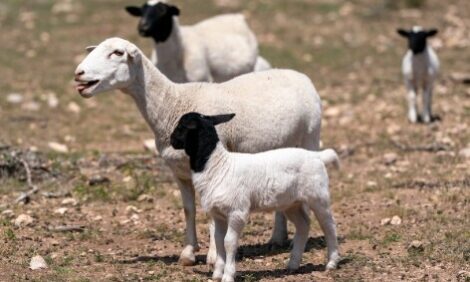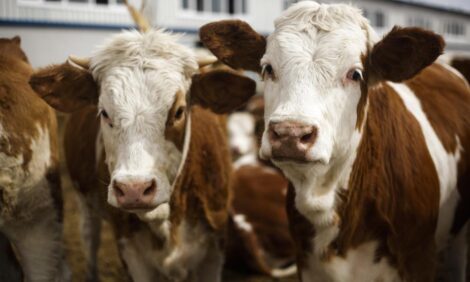



Why do cows bunch together?
Learn more about the stressors that can cause cows to bunchThe dairy farmer will look over the cow pen and notice the cows are bunched up and huddled into a big group. The farmer scratches his head and asks, “Why do cows congregate into a group?” They were not like that before. Unsure of what to do, he gets in the pen and separates the cows, only to find the same group of cows a couple hours later all bunched up again.
I know dairy farmers that have a “cow whisperer” ability. They observe cows keenly and can tell what their cows are thinking! In my many years of dairy consulting, I have observed some unusual bunching behavior of dairy cows in well managed and comfortable barns. I enjoy watching cows and have learned to be a keen observer of dairy cows. My teachers of cow behavior have been my livestock and my “cow whisperer” farmer clients.
A first question to ask is, “Why does it matter that cows bunch together?” When cows bunch together, it compromises production, health, and welfare of the animals. Bunching increases heat stress of the affected cows, increases standing, splashes manure on the udder, and elevates stress hormones. These changes increase risk of lameness, reduces ruminations and feed intake, and results in subsequent loss in milk production that is lower in milk fat.
Dairy farmers provide their cows with quality feed, housing, stalls, and environment. The cows are their livelihood, and their best care is top priority. They remove stressors, and cows then perform to their genetic potential. Cows under stress do not perform well. Bunching of cows is an indicator of some external stressor not initiated or solicitated by the farmer. Why do cow’s bunch in well managed and comfortable barns?
Cow Behavior
Cows were created with a four chambered stomach to consume grass and bunch together as a herd. Herd animals stay together as a group with a social dominance structure. The dominant “boss cow” will direct the herd with subordinate followers. Cows, sheep, and wild animals, including deer, zebra, and a favorite, the wildebeest, are ruminant prey animals. Prey animals are a source of food for predator animals, like lions and cheetahs. Prey animals will congregate together in herds or bunches for protection and survival. In the wild, the wildebeest grazing on the African safari grass will bunch together as a predator cheetah approaches the herd. This is a truly amazing nature sight to behold in person. The catch is exhilarating to watch, but not for the prey. We don’t have cheetahs in our dairy barns as a threat to our cows, but the response to stress is similar – bunch together! Cows will bunch together when under stress because of their God designed instincts.
Bunching can occur in well managed barns as a result of stress of social interactions, environmental stress, flies, electrical stimuli like stray voltage, or limited access to feed or water. A brief review of these factors that cause cows to bunch and possible solutions will follow. Read along and learn.
Social Interactions
Cows reside in herds where a unique social dominance hierarchy exists in each herd. The “boss cow” is the one that gets her way with whatever she desires. First in the parlor, first to the feed bunk, the clean free stall, and she will dictate her preferences with head butting, ear twitching, and tail movement responses. The lower social order cows are typically the first calf heifer that recently calved. Social stress will cause cows to retreat and bunch up. Research has proven that first calf heifers when housed in a separate pen from older cows will perform better. This is partly due to less social distress. If your facilities allow, a separate first calf heifer group is beneficial. Social hierarchy and conflict are most significant in pens of milking cows of all ages when the pen size is 150 cows or less. Automated milking dairy farms with all cows in same pen will observe more social dominant stressors and potential bunching. As a farm manager, do not overcrowd pens, especially with automated milking systems.
Environmental Temperature
Cow bunching can start with as few as three to five cows that are initially stressed, and as environmental temperatures increase, more cows are affected and the bunching group grows in size. Research and time-lapse camera observations would indicate that the most frequent time to observe bunching is 3:00 to 8:00 pm. The initial bunching can start when temperatures are at 68 degrees F or higher. This often can occur in May in the US eastern corn belt. Walk your barns during late afternoon each day and be a “cow whisperer”. What are your cows telling you? If they are standing more and bunching even in small groups or standing near a waterer or drinker, then evaluate the factors that impact bunching. Ask a qualified ventilation technician or cow comfort specialist to conduct an air flow and cow comfort audit to identify areas of each barn that are not properly ventilated or designed. Intervene as soon as bunching occurs, as once cows start to bunch, it is difficult to untrain them.
Microclimates
The external perimeter of the barn can also impact the internal barn environment. A California dairy study from 20 large dairy farms indicated that crops grown adjacent to free stall barns can elevate potential for cow bunching. Trim weeds and brush growing near free stall barns and do not plant corn crops close to free stall barns. Researchers speculated that internal barn airflow is modified when crops or tall weeds were near the barns. Even when fans are present in barns, restrictions to outside airflow can create a micro-environment in pens that initiate cow bunching. High stocking density can compound cow bunching during hot weather. Do not overcrowd, as individual cows in groups are exposed to hotter individual temperatures in the inner circle of the cow’s groups.
On pasture cattle, the reason why cattle may bunch in the warm conditions is not well understood, but one possibility is that bunching may occur around shaded areas as a strategy to reduce heat load. In free stall-housed cattle, they are blocked from direct sunlight during midday. However, radiant direct sun into barns will occur in the US eastern corn belt in the early morning or late afternoon. Sun rays that enter a barn and expose cows to direct sunlight will stratify cows and cause bunching when cows are exposed to direct sun rays.
Cow bunching will be more common in hot summer months. A barn orientation where direct sunlight enters the sides, high producing cows, long day length, and uneven air flow within the barn are all possible causes of cow bunching. Prepare for summer heat by cleaning fan blades and housing mesh. Dirty fans move less air and will create areas of the barn that do not offer airflow. Remove pen pack manure as extra heat and potential for flies is generated from these systems.
Electromagnetic Fields
Farmers have perceived magnetic fields from high voltage lines, automated milking systems, or solar panels as possible causes of bunching behavior in their cows. Housed dairy cows are a greater risk for stray voltage than pastured animals due to the exposure of fans, parlor, automatic milking, and electric panels in housed barns. Dairy cow sensory stimuli start at a much lower voltage than humans. A Danish study evaluated 60 dairy farms and identified bunching on several farms. The risk factors were newly constructed barns, measured stray voltage, and presence of fans in barns. The presence of fans in the barn as a factor for bunching is difficult to speculate the cause, but the observations and research would support that cows standing in front of fans would indicate they locate in front of fans to avoid hot spots in other areas of the barn. Cows will bunch in areas of good airflow to avoid flies, similar to pasture cows that stand in the mud. Fans are electronic devices that can cause stray voltage when in use, and if not properly grounded, they can create stress and cows will bunch. One research study indicated that the noise from fans can initiate a stress response in cows and initiate bunching.
Pests
Stable flies are blood seeking flies that bite the legs of cattle. A California study of 20 commercial free stall herds measured fly counts on cows using traps and observations. Trap counts as few as 50 flies per trap per pen or just 1 fly per leg will cause cows to bunch in free stall pens. The stress of the fly bites causes cows to stand in a tight group with their heads to the center of the group and their tails to the outside to protect themselves against the stable fly attack. Dairy cows are known to have thinner hides than beef cattle, and thus, dairy cows are more susceptible to biting flies. Fly repellent behaviors include tail flicking, foot stomping, head tossing, skin twitching, and ear trembling to reduce the fly attack. An effective fly control program must include a combination of cleanliness, larval control through feed, regular sprays, ear tags and parasitic wasps. Fly control must start early (April / May) to prevent mid to late summer fly issues.
Feed and Water
Cattle will increase drinking in hot temperatures, and they will often bunch around drinkers in hot temperatures. When cows congregate and bunch around drinkers or empty feed bunks, it is a response to stress which can begin a bunching response. Provide extra waterers during the summer. Drinkers should provide a minimum of 25 linear water distance per 100 cows. Water capacity as measured by flow rate is also important that the drinkers are not empty. TMR feed bunks must provide continuous access to fresh feed. A mold inhibitor added to the TMR will maintain freshness and stability of the ration during hot summer months. Provide a minimum of 200 feet of bunk length per 100 cows or 24 inches per cow. Overcrowded pens or limited bunk space with limited feed availability can create opportunities for cows to bunch up, especially during hot weather.
Summary
Dairy farmers provide quality care for their cows by providing proper feed, water, comfort, ventilation, and housing. As a result of quality care, cows respond by providing consumers with high quality, nutritious milk we can all enjoy. As a dairy farmer, take time now to get the barns in order for summer time. Keep the predators of stress away with proper prevention. Areas to manage to prevent bunching this summer include effective cleaning of fans, proper fly control, trim grass and weeds around barns, and check for stray voltage, especially from fans and drinkers. Most of all, monitor the barns each afternoon to observe and head off any potential stressors that may cause cows to bunch up.


